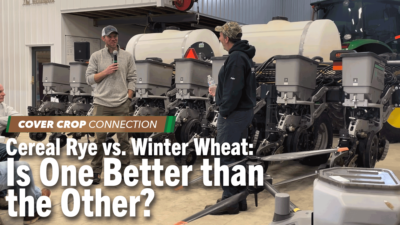By: Andrea Johnson
Mikayla Tabert likes to graze cattle in northern Minnesota much longer than most people believe possible.
She and her family, including her husband, Benjamin Tabert, and her parents, David and Peggy Miller, aspire to graze year-round, as long as winter conditions and feed availability allow.
Even in January, February, and March, the Taberts/Millers have successfully fed cows on field crop residue plus big round bales of hay set up in grids. It’s a technique called bale grazing. Eventually, the snow gets too deep, or they run out of stockpiled feed, but until then, the cattle are resourceful at finding feed from the last growing season.
One of the keys to their success is treating harvested fields as grazing lands. The Taberts/Millers put their cattle out on farmland with temporary or permanent fencing to eat crop residue and cover crops.
It is their goal to plant a cover crop on every farm acre – not just for grazing, but to suppress weeds, build soil health, and control soil erosion.
In this late June report, Mikayla explained how they interseed into 30-inch rows of corn or sunflowers. Because both crops mature so late, the cover crop must be established during the growing season.
They purchased a side dress unit designed to apply 28 percent UAN. Benjamin and David took off the row units and installed John Deere row opener units and a Valmar box to meter cover crop seed.
When the corn is at the V4-V5 stage, the Taberts/Millers plant twin rows of the cover crop mix (10-12 plant species) between the 30-inch rows, while also applying 28 percent UAN via a modified Y-drop.
Sunflower planting was just completed June 6-9, so they will interseed/side dress the sunflowers after corn interseeding is complete.
“The sunflowers end up having a different cover crop mix, but otherwise it’s pretty much handled the same as corn,” she said.
Mikayla added that before they built their side dress unit/cover crop seeder, they tried a similar design using a cultivator tool bar fit with row openers, and a Gandy box just for planting cover crops. It was their test model before they invested in the side dress unit.
By seeding the cover crops in June or July, germination, emergence, and growth is likely to occur – although it was a challenge with the severe drought of 2021.
The 2022 growing season – with heavy rainfall – is looking much more promising for cover crop production in corn and sunflower fields.
Trinity Creek Ranch’s other crops will receive cover crop seedings later in the season.
The cow/calf herd looked great, and there were just three cows left to calve in late June. Everyone was concerned about excessive heat in the forecast.
“We are thankful to have paddocks with trees,” she said.
Their system for grazing and moving cattle is low stress, so that is helpful when the weather is hot. The perennial pastures have permanent fencing. The crew opens a gate and the cows are trained to move into the next paddock.
“They are used to moving, so usually once we drive the ATVs out there, they come running and follow,” she said. “This is trickier with baby calves that do not know the system yet. We generally don’t shut the gate behind them so the mama cows can go back for their calves, and/or we must go behind to push the stragglers along. Sometimes the cows stay with their calves, but other times the cows take off and come back later for their calves.”
After last year’s drought, the Taberts/Millers are grateful for their 2022 hay crop. The crew started cutting alfalfa on June 16, and they planned to cut hay over the last two weeks of June.
“We don’t usually like to have all of it down at once,” Mikayla explained.
In addition, herbicide treatments continued.
“In general, the fields are pretty clean,” she said. “On the wheat side, some of the tougher weeds got through Aim and glyphosate.”
Their herbicide options are limited due to cover crop rotation and grazing restrictions.
“This year, we are seeing weeds like white cockle, Canada thistle, and perennial sow thistle. In general, switching to no-till gets you a different weed profile,” she concluded.




Post a comment
Report Abusive Comment